16/05/2022
Sensors are everywhere. And there are more of them every day. Some researchers have predicted that by 2035, there will be 1 trillion “internet of things” (IOT) devices, nearly all of them relying on sensors.
Sensors are being increasingly incorporated in manufacturing, transportation (for example, in shipping containers), and buildings. Some of these sensors can monitor air pollution or airborne pathogens – the latter having become increasingly important in the ongoing Covid-19 pandemic.
Currently, most of these sensors are powered by batteries. However, some sensors of the future, and indeed, of the present, are employed in difficult, or impossible, to access locations, where a battery, having limited capacity, may not be ideal for powering the sensor in the long term. A battery can also add significantly to the weight and volume of a sensor. But research is under way to ensure that many of the sensors needn’t rely (solely) on separate power sources, but can harvest or “scavenge” energy from their environments to power them.
Scavenging energy from light, heat, and motion
Photovoltaic power generation is seen as one of the keys on the path to net zero, and offers a well-established way of powering sensors. However, as more and more sensors are employed indoors, whether it be in manufacturing facilities, transportation, or residential and commercial buildings, alternative sources of energy may be required.
Photoelectric generators capable of scavenging energy from artificial light, which is not only less powerful but also of a different wavelength than solar radiation, may be the answer. However, as the usefulness of such energy generation is limited to locations and applications in which artificial light is present, other alternatives are being developed.
Alternatives to photoelectric harvesting include:
- thermoelectric harvesting using the Seeback effect, which relies on a temperature difference across a conductive material creating a voltage at the ends of the conductive material;
- induction harvesting relying on induction effects from electromagnetic radiation; and
- harvesting of mechanical energy.
Harvesting mechanical energy
Harvesting mechanical energy or motion may be separated into three separate technologies: harvesting of vibration (such as engine vibrations in vehicles) and reciprocating motion (e.g., a finger press), piezoelectric harvesting, and friction harvesting.
Piezoelectric harvesting uses certain materials which generate a current when put under mechanical stress. These piezoelectric materials can be crystalline, ceramic (e.g. barium titanate), or polymeric (such as PVDF).
Most friction harvesting relies on triboelectric nanogenerators (or TENGs) – TENGs convert mechanical energy into electricity by using the triboelectric effect and electrostatic inductions. The triboelectric effect relies on a static charge being created by rubbing together two triboelectric materials – a common example of which is the charge created when a balloon is rubbed against hair.
How TENGs may lead to better wearables
Wearables are a particularly promising application for TENGs, as, unlike batteries, many triboelectric materials can easily be provided in fabrics (e.g. by weaving them into the fabrics themselves). Wearables, or wearable technology, encompasses smart electronic technology worn on, or near, a human’s body (in particular their skin) to monitor, and at times even influence, their body signals. Some wearable technology may be adapted for use in animals, such as dogs and cats. The most common example of a wearable is the, now ubiquitous, smartwatch, although “wearable” clothing is also becoming more widely available – and perhaps TENGs will be essential in making such clothing more common.
What can patenting activity tell us about the future of these energy harvesting technologies?
As shown in Figure 1, in the past decade, patenting activity has increased significantly in CPC patent classes related to all of thermoelectric harvesting (H01L35/30), harvesting of vibration and reciprocating motion (H02K35/02), piezoelectric harvesting (H02N2/18), and TENGs (H02N1/04).
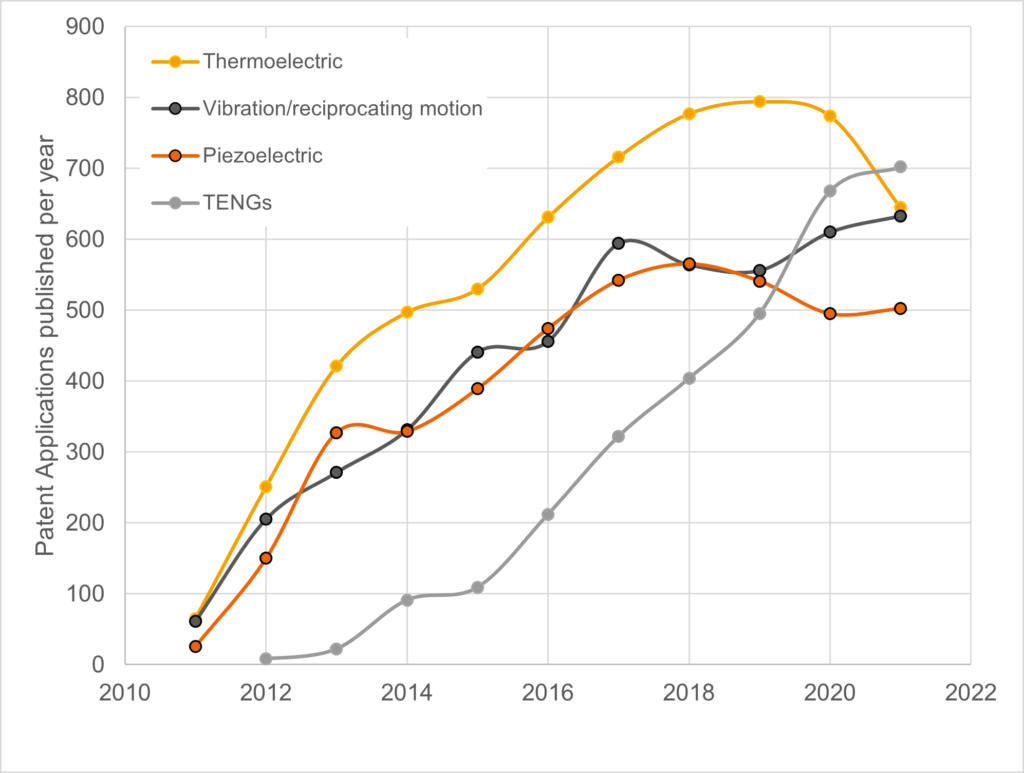
In all of these CPC classes, the number of applications published per year has increased by at least six-fold in the past decade – with patent publications in the CPC class related to TENGs (H02N1/04) increasing from almost none a decade ago to over 700 in 2021. This supports the idea that as sensors and wearables become more common, research and development (and, by proxy, patenting activity) in energy harvesting is increasing.
Looking in some more detail at the biggest filers of patents in these classes reveals differing filing patterns for these technologies, which may indicate the different levels at which research is being conducted.
As shown in Figure 2a, some of the largest filers for thermoelectric harvesting inventions (in CPC H01L35/30) are large multinationals such as LG, Hyundai and Valeo. However, more specialist manufacturers such as Kelk and Gentherm also file a large number of patent applications in this field.
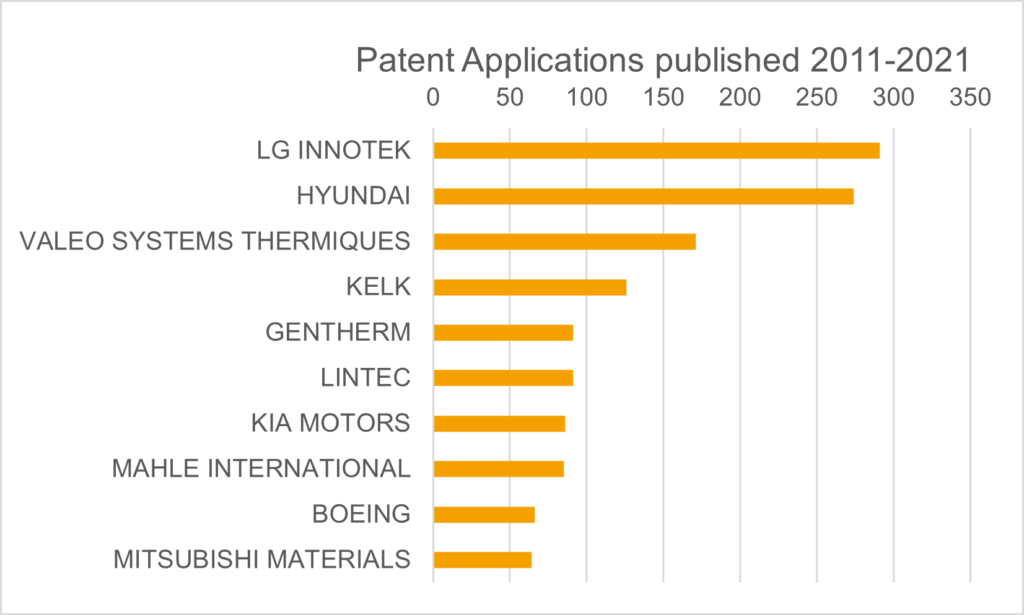
Looking at the largest filers in harvesting of vibration and reciprocating motion (in CPC H02K35/02) reveals Linptech, a specialist manufacturer of self-powered doorbells and switches, as the largest filer, with many (Chinese) universities and some multinationals (Mitsumi, ZF) also in the Top 10 of filers (see Figure 2b)
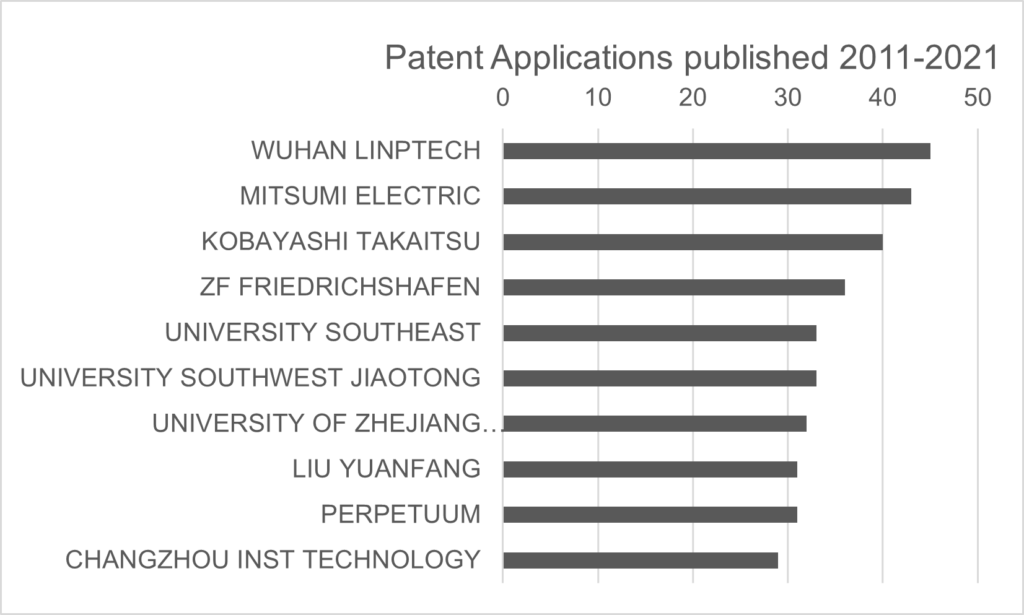
The picture regarding patenting for piezoelectric harvesting (in CPC H02N2/18) is not dissimilar to that for thermoelectric harvesting inventions, as shown in Figure 2c: large multinationals such as Samsung, Murata, CEA and STMicroelectronics file the most patent applications, with more specialist companies such as Oscilla Power, a company that develops wave energy converters, rounding out the top filers.
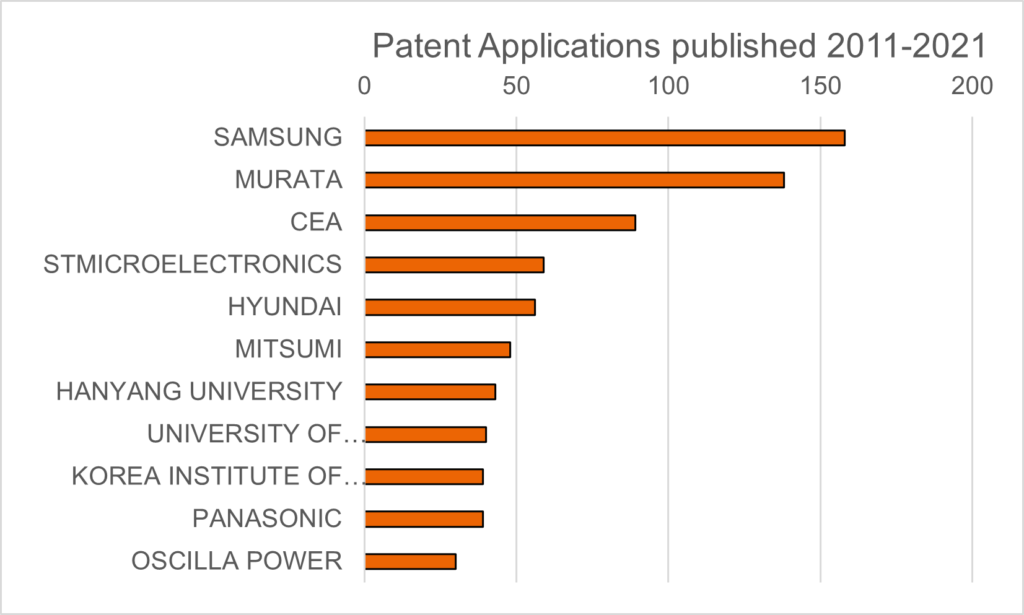
Finally, looking at Figure 2d which shows the Top 10 filers for TENGs (in CPC H02N1/04), by far the largest filer is Beijing Institute of Nanoenergy and Nanosystems, which had over 250 patent applications published in this CPC class in the last decade. Multinationals such as Samsung and Philips and other universities also belong to the largest filers, as well as more specialist companies such as Newnagy Tangshan.
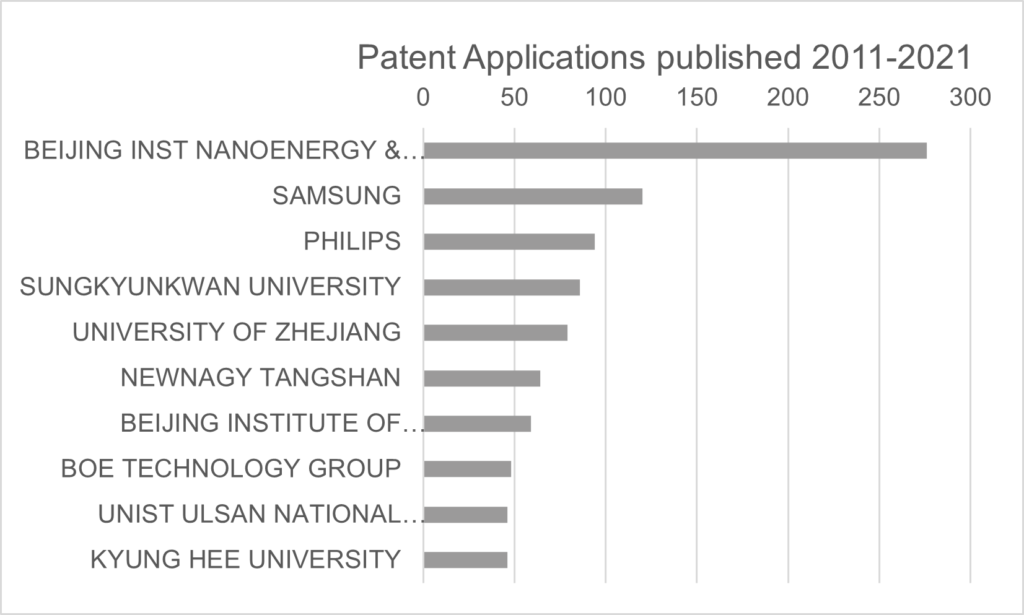
From the above, it is clear that while multinationals are large filers in all CPC classes related to energy harvesting, universities and smaller, more specialist companies also have significant numbers of patent applications published in these areas. The interest in these energy harvesting technologies clearly stretches across academia, SMEs and multinationals.
Final thoughts
The above patent data highlights that research and development is increasing in all areas related to energy harvesting suitable for powering the sensors of the future, including in wearables. The possible applications are endless, and hold great promise.
These energy harvesting technologies may be seen as alternative to one another. However, due to the large variety of possible applications, we expect that there will nevertheless be a market for all of these technologies, given the predicted significant increase in the number of sensors in the near future.
TENGs certainly appear to hold great promise for applications in wearables. Those who own the key patents to the technology will certainly be in a good position to benefit from the “sensor age”. If you wish to discuss how to best protect your inventions in this field, or any other energy harvesting technology, or if you work in this space and want to know whether others’ patents or patent applications may be an issue for your freedom to operate, please get in touch.
This article is for general information only. Its content is not a statement of the law on any subject and does not constitute advice. Please contact Reddie & Grose LLP for advice before taking any action in reliance on it.


